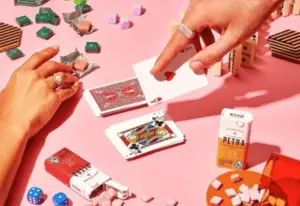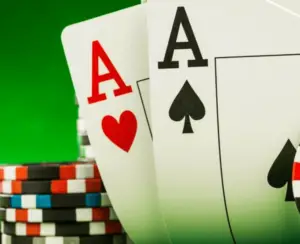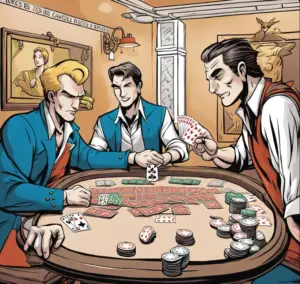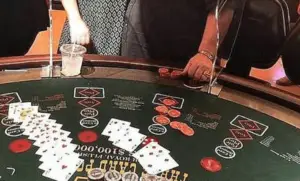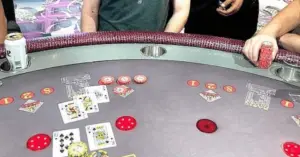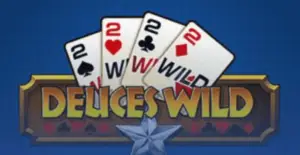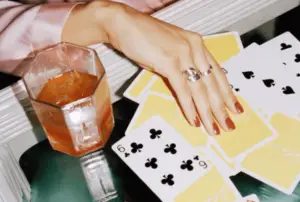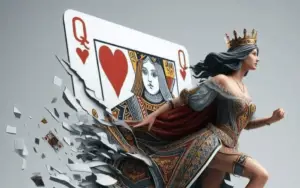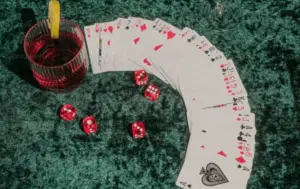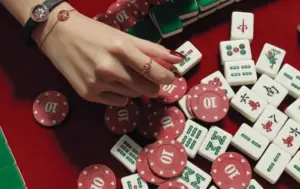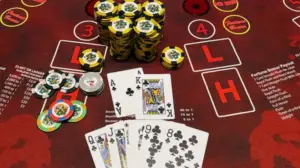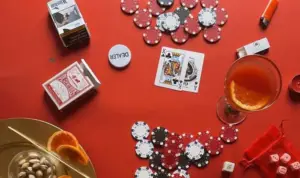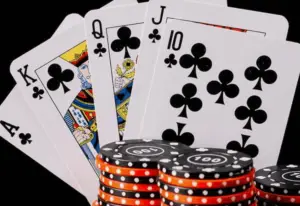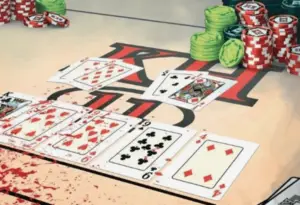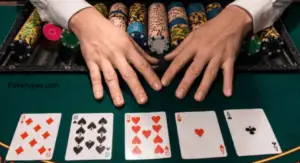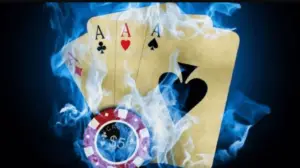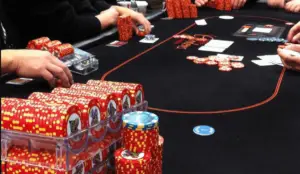Draw poker is a classic variation of the popular card game, in which each player is dealt a complete hand before betting begins.
It’s been a beloved pastime since the early 1800s, possibly originating in the saloons of New Orleans.
The game spread rapidly via steamboats up the Mississippi and Ohio rivers, and later by wagon trains and railroads as the American frontier expanded westward.
Five-card draw, the most common version, has long been a staple of home games, although it’s less prevalent in casinos and tournaments today compared to stud poker and community card poker.
As one of the most iconic embodiments of the American spirit and Old West gambling, draw poker has a rich history and engaging gameplay.
How to Play Draw Poker?
Come learn how to play draw poker, which is easy to learn but takes skill to master. Here’s a step-by-step guide to get you started:
1. Ante Up or Post Blinds
Before the cards are dealt, each player puts in an ante (a small bet) or the two players to the left of the dealer put in blinds (forced bets). The small blind is usually half the size of the big blind.
2. Deal ‘Em Out
The dealer gives each player five cards face down. In some variations, the number of cards dealt differs, but five is the most common.
3. Place Your Bets
After peeking at their cards, the player to the left of the big blind starts the betting round. They can fold (quit the hand), call (match the big blind), or raise (increase the bet). Betting continues clockwise until everyone has either called the highest bet or folded.
4. Draw for Better Cards
Now’s your chance to swap out cards you don’t want. Starting with the player to the dealer’s left, each player says how many cards they want to discard and draw from the deck. You usually can’t draw more than three cards, and sometimes you can only draw once.
5. Bet Again
After the draw, there’s another betting round starting with the player to the dealer’s left. They can check (bet nothing) or bet. If someone bets, the next player can fold, call, or raise. The round ends when all players have either called the highest bet or folded.
6. Show Your Hand
It’s the moment of truth! If more than one player is still in the game after the final betting round, it’s time for the showdown.
The last player to bet shows their cards first, then everyone else reveals their hands. The best five-card poker hand wins the pot. Some cool variations to try:
Jacks or Better: You need at least a pair of jacks to bet
Spit in the Ocean: Instead of drawing from the deck, there are cards face-up on the table that anyone can use
Deuces Wild: All twos are wild cards
Draw poker has existed since the 1800s and was especially popular in the American West. Back then, folks played with just 20 cards (tens through aces), but now most games use a 52-card deck.
So round up some friends, grab a deck of cards, and give draw poker a try! It’s a great game for 2 to 8 players. Just remember to keep a poker face and have fun!
Draw Poker Rules
Now let’s get down to business with draw poker rules! First off, you’ll need a standard 52-card deck to get the game going. No jokers allowed, unless you’re feeling wild and decide to use them as wild cards.
When it comes to hand rankings, it’s the same old story: royal flush reigns supreme, followed by a straight flush, four of a kind, and so on down the line.
But here’s where things get interesting – in some draw poker variants like lowball, the goal is to get the worst possible hand! In deuce-to-seven lowball, for example, the best hand is 2-3-4-5-7 (just don’t go for a straight or flush, or you’re sunk).
Now, let’s talk about betting structures. You’ve got your classic fixed limit, where the betting amounts are set in stone for each round.
Then there’s the pot limit, where you can bet up to the current size of the pot. And if you’re feeling lucky, go for no limit and bet your whole stack!
In most draw poker games, you’ll have a dealer button to keep track of who’s dealing and a couple of blinds (forced bets) to get the action started.
The player to the left of the dealer puts in the small blind, and the next player over puts in the big blind, which is usually double the small blind.
But wait, there’s more! Each draw poker variant has its own quirks and rules to keep things spicy. In a five-card draw, you start with five cards and can swap out up to three (or four, if you’re feeling brave) during the draw round.
In triple draw lowball, you get three chances to perfect your hand, with betting rounds in between each draw.
Draw Poker Variants
Hold on to your hats, we’re exploring draw poker variants! From the classic five-card draw to the mind-bending badugi, there’s a flavor of draw poker for every kind of card shark out there.
Five-Card Draw: The OG of Draw Poker
Let’s start with the granddaddy of ’em all: five-card draw. This is the game that pops into most people’s heads when they hear “draw poker.” It’s simple, it’s classic, and it’s been around since the 19th century. Here’s how it goes down:
Each player antes up or posts blinds.
Everyone gets dealt five cards, face down.
Betting round #1 kicks off.
Players can discard up to three cards (or four if they’re showing off with an ace).
Replacement cards are dealt.
Betting round #2, and then showdown!
The goal? Make the best five-card poker hand possible. We’re talking royal flushes, straights, full houses – you know the drill.
Five-card draw is the perfect gateway game for newbies learning the ropes of draw poker. It’s easy to pick up, but there’s still plenty of strategy involved. You gotta know when to hold ’em and when to fold ’em, as the saying goes.
Lowball: Flip the Script
Now, let’s flip the script with some lowball variants. In these topsy-turvy games, the worst hand wins! It’s like the opposite day at the poker table.
First up, we’ve got ace-to-five lowball, also known as California lowball. In this game, aces are low, and straights and flushes don’t count against you. The best possible hand? 5-4-3-2-A, also known as the “wheel.”Then there’s deuce-to-seven lowball, where aces are high, and straights and flushes do count against you.
The nuts in this game are 7-5-4-3-2, nicknamed the “nuts.”Both of these lowball games usually involve multiple drawing rounds, upping the stakes and the strategy. You gotta balance your bluffs and your value bets while trying to nail that perfect low hand.
Badugi: Four Cards, Four Suits
Ready for something a little more out there? Say hello to Badugi, a four-card poker variant that originated in Korea.
In Badugi, each player aims to make the best “badugi” hand: four cards of different suits and ranks. An A-2-3-4 of all different suits is the nuts, while K-Q-J-T of the same suit is about as bad as it gets. The game starts with a small blind, a big blind, and a draw. Players can discard up to four cards, and then there’s another round of betting. Rinse and repeat for two more draws and betting rounds.
Badugi is a fun twist on traditional draw poker that rewards a different kind of strategic thinking. You’ve gotta be willing to ditch that pair of kings if it means completing your badugi!
Triple Draw: Three Times the Fun
If one drawing round just isn’t enough for you, then triple draw is your game. As the name suggests, this variant features three separate drawing rounds, with betting in between each one.
The most common triple draw games are deuce-to-seven and ace-to-five, played at fixed-limit stakes. But there are plenty of other variations out there, like badugi, badacey, and badeucey.
In the triple draw, the position is key. You want to be the last one to act so you can see what everyone else is doing before deciding on your own discards. Bluffing and semi-bluffing are also crucial strategies since you have three chances to improve your hand.
Other Wild Variants
Feeling adventurous? Then check out some of these other wacky draw poker variants:
California High/Low Split: Half the pot goes to the best high hand, half to the best low hand. Gotta balance those drawing decisions!
Archie: A wild game where you can buy a sixth card for double the ante. More cards, more possibilities.
Q-Ball: Another split-pot game, but this time with an extra twist – the Q♣ is wild!
Draw poker is vast and varied, with new games invented constantly. Every player has something to learn and master, whether they are a purist who sticks to five-card draw or a maverick who enjoys the crazier variants.
Draw Poker Strategies
Starting Hand Selection
When it comes to starting hands, it’s all about playing smart from the get-go.
Playing Tight from Early Positions
If you’re one of the first to act, keep it tight! Stick to premium hands like high pairs, big aces, and strong Broadway combos. You don’t want to get caught with your pants down when someone raises behind you.
Widening Range in Later Positions
As you get closer to the button, you can loosen up a bit. With fewer players left to act, you’ve got more room to get creative with suited connectors, small pairs, and speculative hands. Just don’t go overboard!
Betting Strategies
Alright, you’ve got a decent starting hand. Now what?
Raising with Strong Hands
When you’ve got the goods, don’t be afraid to put in a raise. Build that pot and make your opponents pay to see those sweet, sweet community cards. 3-betting can be a powerful tool, especially against loose players who can’t resist a draw.
Bluffing and Semi-Bluffing
Bluffing is the heart and soul of poker. In draw games, semi-bluffing with hands that have good potential to improve on the draw can be incredibly effective. Just make sure you’re telling a believable story with your bets.
Drawing Strategies
The draw is where the magic happens in draw poker. Here’s how you can use it effectively:
When to Draw and How Many Cards to Exchange
If you’ve got a made hand like a straight or flush, you might not need to draw at all. But if you’re chasing a draw, consider the pot odds and your chances of hitting before deciding how many cards to swap.
Balancing Drawing Patterns to Avoid Predictability
Mix it up! If you always draw three cards when you have a pair, observant opponents will catch on. Sometimes draw one or two cards with a strong hand to keep them guessing.
Position and Hand Ranges
Position is king in poker, and draw games are no exception.
Importance of Position in Draw Poker
Being last to act gives you a huge informational advantage. You get to see how many cards everyone else is drawing before making your own decision. Use that intel wisely!
Adjusting Hand Ranges Based on Position
In the early position, stick to those premium starting hands we talked about. But in late position, you can widen your range and play more speculative hands, especially if the pot is unraised and you’re getting good odds to draw.
Reading Opponents and Tells
Poker is as much about reading people as it is about the cards.
Observing Opponents’ Drawing Patterns and Betting Behavior
Pay attention to how many cards your opponents are drawing and how they size their bets. Are they always check-raising after drawing one? They might be slow-playing a monster!
Physical Tells and Behavioral Patterns
Watch for those classic poker tells like shaking hands, darting eyes, or changes in breathing. But be careful – some crafty players might be faking tells to throw you off! There you have it, folks – a crash course in draw poker strategy. Remember, it’s all about playing your position, selecting smart starting hands, and reading your opponents. Now get out there and start raking in those pots!
Draw Poker Tips for Beginners
Hey there, all you aspiring card sharks! Ready to dive into the exciting world of draw poker? Here are some tips to get you started on the right foot.
Learn the Rules and Hand Rankings
First things first, you gotta know the lay of the land. Familiarize yourself with the basic rules of draw poker and the hand rankings. In most variations, the best possible hand is a royal flush (A-K-Q-J-10 of the same suit), followed by a straight flush, four of a kind, full house, and so on down the line. Commit these rankings to memory – they’re your bread and butter!
Start with Simple Variants like Five-Card Draw
When you’re just starting out, keep it simple. Five-Card Draw is the perfect game for beginners.
Each player gets dealt five cards, there’s a round of betting, and then players can discard and draw new cards to improve their hand. After another round of betting, the best hand wins the pot. Easy peasy!
Play Low Stakes or Free Online Games to Practice
No need to break the bank while you’re learning the ropes. Start with low stakes games or even free online games to get a feel for the flow of the game.
Many online poker sites offer free play options, so take advantage of those to hone your skills without risking any real dough.
Focus on Starting Hand Selection and Position
One of the keys to success in draw poker is knowing which starting hands to play and which to fold. As a general rule, you want to play strong hands like high pairs, three of a kind, and four to a flush or straight.
Your position at the table also matters – the later you act, the more information you have about your opponents’ hands, so you can play a wider range of starting hands.
Avoid Chasing Draws with Poor Odds
It can be tempting to chase that flush or straight draw, but be careful! The odds of completing your draw are often lower than you think.
For example, if you have four cards to a flush on the draw, you only have about a 19% chance of hitting your flush by the river. Don’t go broke chasing long-shot draws – focus on playing strong-made hands instead.
Here are a few more quick tips to keep in mind:
Pay attention to how many cards your opponents are drawing. If they’re drawing one or two cards, they likely have a strong hand already.
Don’t be afraid to fold if you don’t have a strong hand or draw. There’s no shame in living to fight another day!
Mix up your play to keep your opponents guessing. If you always draw three cards when you have a pair, savvy players will pick up on that tell.
So there you have it – some basic tips to get you started in the world of draw poker. Remember, practice makes perfect, so don’t get discouraged if you don’t win every hand right away.
Keep at it, stay focused, and most importantly – have fun! Who knows, with a little luck and a lot of skill, you might just become the next poker legend. Happy drawing!
Conclusion
Draw poker provides endless opportunities for skill development and strategy development. With a solid understanding of starting hand selection, position, betting, and drawing, you’ll be well on your way to becoming a formidable player.
Remember to start with simple variants like Five-Card Draw, play within your bankroll, and avoid chasing long-shot draws.
Most importantly, have fun and enjoy the camaraderie and excitement that draw poker has to offer. With practice and dedication, you’ll be raking in pots and bluffing with the best of them in no time!

